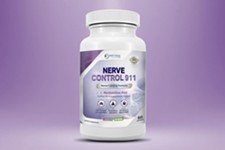You Want to Do What? Where?
Internal Pelvic Floor Therapy gives new meaning to inner journeys
By R.U. Steinberg, 3:40PM, Thu. Nov. 18, 2010

The human body is a remarkable machine and even after thousands of years of study, we continue to learn more about its many mysteries within. Unfortunately, over time, that machine starts showing signs of wear and tear, sometimes in ways we could have never imagined.
Some of the aches and pains we experience are too embarrassing to even mention to friends and loved ones. Take issues of the pelvis, for example. No, I am not referring to our inability to gyrate like Elvis Presley. Most of us are already resigned to the fact that we will never thrust about with quite the same chutzpah as the King.
What I am referring to are issues of the pelvic area like groin pain, pain when you have sex, frequent urges to urinate, incontinence, bladder leakage, and irregularity – you know, "the fun stuff," the stuff we used to laugh about as kids, but now we're grown-ups and it's not so funny anymore. Some of these conditions are the result of identifiable medical conditions. For example in some women, the rigors of childbirth can leave the body a little worse for the wear. Or for men, an enlarged prostate can literally and figuratively be a real "pain in the butt." For both sexes, there are various physical issues and the like, some of which are caused by something as simple as bad posture.
We go to health care professionals with such aches and pains, but the treatment doesn't seem to work. We try to change our diets, take laxatives, eat more fiber, or get prescribed muscle relaxants, painkillers, or bladder control medicines, but nothing really makes the problem go away. We may be told our bladders are distended or we have small hernias that aren't worth surgery. We may get labeled with conditions like Interstitial Cystitis, Painful Bladder Syndrome, Pelvic Pain Syndrome, Pelvic Floor Muscle Spasm, Nonbacterial Chronic Prostatitism, Pudendal Neuralgia, Vulvodynia, or Irritable Bowel Syndrome.
If you have gone through all forms of conventional Eastern and Western diagnosis and treatment and ruled out everything else, but are still experiencing symptoms – like frequent urges to go to the bathroom at night – there may be a form of treatment you hadn't tried or even heard about involving the fascia called internal pelvic floor therapy.
If you have ever had any physical work done on you – massage, physical therapy, chiropractic, etc. – you have probably heard about fascia. Fascia and myofascia are the general terms for the continuous, three dimensional connective tissue system that is joined to every structure in our body. You can think of fascia as being like cheesecloth. When we get injured, tense, or sit with bad posture over a long period, our fascia can twist and tie up, resulting in a constriction in the flow of blood, lymph, and nerves. By working with a specially trained person, our fascia can be relaxed, allowing blood and lymphatic fluids to flow freely to our muscles, joints, bones, organs, and nervous system to work more effectively.
Fascial/mysofascial pain is very real and its importance in receiving treatment is still being realized. The late Dr. Janet G. Travell was a pioneer in the developing myofascial pain treatment. As President John F. Kennedy's personal White House physician, she relieved his severe and chronic back pain. Her research showed that each trigger point in a muscle could produce pain and other symptoms in another part of the body.
Working on the outside of our bodies – well, there's nothing quite like getting a massage, an adjustment by a chiropractor, treatment through acupuncture, or working with a physical therapist. Working on the inside of our bodies, well, that's a different matter. Or is it? Most people would wince or reject the idea of having someone treat them on the inside by going through the vagina or rectum. As squeamish as this might make us, internal trigger points and external trigger points work the same way. Release internal trigger points and pain, frequent urges to go the bathroom, or other symptoms can go away.
Such internal treatment has been with us for decades and has basis in modern medical practice. Most women have heard of or performed Kegel exercises, named after Dr. Arnold H. Kegel, a gynecologist who developed them in the 1940s as a non-surgical treatment to relax the genital area to fix urinary incontinence and pelvic pain caused by weakness in the muscles (also known as pelvic floor weakness). As far as men are concerned, some time before World War II, Dr. George H. Thiele developed a technique of massaging muscles internally to treat prostate pain and pelvic floor problems.
In its most basic sense, internal pelvic floor therapy involves a physical therapist using his/her finger to examine trigger points inside a person's body that are affecting the bladder, tailbone, urethra, prostate (in men), and other organs. Through this physical examination and treatment, therapists can identify tightness and tenderness and gently stretch the connecting muscle.
Over the years, many gynecologists, urologists, osteopaths, and other medical professionals have recognized and prescribed internal pelvic floor treatment for their patients. The treatment is usually done by specially trained physical therapists. Many have followed the wisdom of John F. Barnes, a physical therapist based in Sedona, AZ and Paoli, PA, who is considered a bit of a guru in some parts of the physical therapy community. Since 1960, he has trained over 50,000 therapists and physicians in internal and external myofascial release.
Fortunately, the Austin area is home to several physical therapists whose practice includes internal pelvic floor therapy. Many of these physical therapists have been trained by Barnes, including Erin Arnold, PT and Laura Holzworth, PT, DPT.
Arnold is a physical therapist with Hands On Physical Therapy in Round Rock. Led by Jody Hendryx, the clinic has specialized in manual therapy and myofascial release since its opening in 1994. While all the therapists there do external work, they also offer internal treatment. "Having seven therapists at one facility performing pelvic floor treatment is very rare," said Arnold. "As a therapist it is extremely rewarding to see the major changes in patient's quality of life with pelvic floor work. Whether it is being able to sleep through the night without needing to use the bathroom, to resuming a normal sex life after previous very painful intercourse, people's lives are definitely changed. I wish more therapists did this sort of work." Arnold herself says she received myofascial therapy before and after the delivery of her child and feels that this treatment was essential for her to have a very few issues with delivery and allowed her to recover more quickly.
Holzworth is a physical therapist with New Dimensions Physical Therapy in Austin. Led by Rebecca Kern Steiner, the clinic specializes in treating athletes and women's health. "I first realized the value of pelvic floor work when I volunteered my own pelvis to a male colleague who went to a women's health training class," said Holzworth. "It changed my life; it made me aware that tension in my pelvic floor was contributing to my migraine headaches. After that weekend, the frequency and intensity of my headaches was about half of what it had been. If someone had recommended pelvic floor work to get rid of my headaches, I would have laughed and declined politely. Now that I've had consistent work and both my migraines and shoulder pain are gone, I am a big proponent of this work for all conditions. Before I arrived, the clinic concentrated on external factors affecting the pelvic rotator cuff. I can add another dimension to treatment with visceral and internal pelvic floor techniques."
Holzworth said most people don't realize that the pelvic area is particularly susceptible to injury. "The pelvis is in the central part of our bodies, and its job is to transfer loads for coordination of function and movement. We can inadvertently tweak a muscle and create a muscle imbalance that literally does not show up for months. The body will borrow from other muscles groups to keep functioning. One day we wake up, and literally can't get out of bed. It only takes a pebble to start an avalanche."
Arnold said pain in one part of our pelvic area can radiate to other parts of our body. "The increased tenderness in these muscles can cause pain not only in the pelvis, but certainly also to the lower back and abdomen and even cause symptoms in the extremities. I think people don't realize that over time when their pelvic muscles aren't working correctly, it can lead to other chronic pain symptoms. Our bodies are amazing at compensating for imbalances up to a certain point. Unfortunately, sometimes these imbalances become too severe and the resulting pain symptom may show up in a very different place than the source of the original restriction."
Arnold had one patient recently who had tried various treatments and nothing worked. "He had the urge to go to the bathroom as many as 12 times a night with pain and his quality of life had gone downhill due to lack of sleep. He tried several medications and none had helped. He almost canceled a family summer vacation. Although he was a little hesitant at first, by the time I saw him he was willing to try internal treatment. After the first session, he reported that his symptoms had lessened. Within a couple months, he was on the road to recovery. He is now able to sleep at night and his symptoms are no longer affecting his work and social life."
Not everyone has been so open-minded about receiving internal treatment. "I remember one patient who was referred to me and refused it," said Holzworth. "Obviously, I realize this is a sensitive situation and respect people's feelings. I treated her externally with some success, but we reached a plateau. When she had a follow-up with her physician, she reported about the external treatment only and the physician urged her to come back for internal treatment. After her first session of internal work, she came back reporting a 75% reduction in leakage and was no longer wearing a pad. Unfortunately, she was only able to have three more sessions before her insurance benefits ran out. She remarked she wished she had tried the internal releasing sooner."
Is internal pelvic floor therapy only for the "aged and disabled" set? Both Arnold and Holzworth have treated people in their 20s. In fact, they've even treated athletes. Holzworth adds that she has helped runners who have, unknowingly, been using a faulty running pattern. "By releasing a runner's internal pelvic diaphragm, she can now use muscles that she couldn't before and change the pattern. She can run with less pain, more pelvic stability, and less or no leakage of urine."
While internal pelvic floor therapy is done in a therapist's office, there are exercises that patients can do on their own. Most exercises are external and involve using a foam roll or an inflatable ball (about the size of a softball). Both male and female patients are coached in doing Kegel exercises and other self-treatments.
Often, patients have partners who are willing to do internal work at home. Arnold and Holzworth have trained partners on doing basic internal work. "It's great when one of our patients has a partner who is willing to work with them at home," said Holzworth. "This can be an uncomfortable situation and not everybody wants to do this for their partner, even if they already have an intimate relationship."
If you are interested in learning more about internal pelvic floor, ask your physician, urologist, gynecologist, or OB/GYN. The International Pelvic Pain Society offers more information and lists providers in Texas, as well as across the world.
A note to readers: Bold and uncensored, The Austin Chronicle has been Austin’s independent news source for over 40 years, expressing the community’s political and environmental concerns and supporting its active cultural scene. Now more than ever, we need your support to continue supplying Austin with independent, free press. If real news is important to you, please consider making a donation of $5, $10 or whatever you can afford, to help keep our journalism on stands.
May 10, 2021
March 30, 2021
July 24, 2020
Health, myofascia, fascia, pelvic, pelvic floor, internal pelvic floor, pain, stress, women's health, men's health, posture










